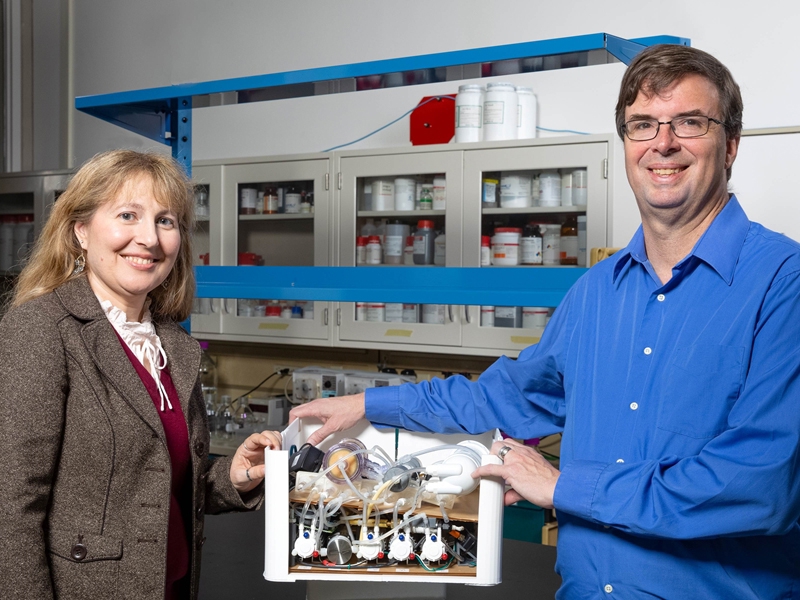
"We have complementary skill sets in terms of what we both are good at," explains Christa Hestekin, professor of chemical engineering, talking aboout her working relationship with her husband, Jamie. "Jamie's really good at looking at the big picture and coming up with innovative ideas. I'm good at the day-to-day and the details of actually making them happen and then come to fruition."
"Christa is really good at advising students, writing the papers and helping prepare for presentations," elaborates Jamie Hestekin, also a chemical engineering professor. "I'm the technology guy. I travel to see the companies more and to some of the conferences, and so it ends up a pretty good relationship between the two of us."
In the simplest terms, Christa describes her background as being in "electrically driven, biologically-based separations" while Jamie's background is in "membranes and charge driven separation." Together, as heads of the Hestekin Lab, they are developing an artificial kidney intended to give patients with kidney disease more options and independence, while potentially reducing Medicare expenditures significantly. The effort is in collaboration with Dr. Ira Kurtz and the US Kidney Research Corporation. With $4 million in funding from the company, the research team, including students in the Hestekin Lab, are building a prototype device that fits on a desktop. It's designed to be used at work or placed on a bedside table and used while a patient sleeps.
"A kidney has two things," Jamie explains. "It's got a glomerulus and it's got a nephron. A glomerulus filters out the big stuff and sends it back. The nephron is where the magic happens — where it selectively removes the very specific things that need to come in and out of the body. Our device is very similar. Instead of a glomerulus, we have an ultra-filtration membrane. It just takes out the red blood cells, proteins, things like that. And then we have several different pieces put together that make the nephron, right? And in our role, all you need to know is that these are all membrane pieces that work together to do the selective transport of the kidney."
"The key difference between our artificial kidney and dialysis is that dialysis is a very passive transport method," Christa says. "So it uses concentration gradients to passively transport molecules. Our system uses active transport in order to help control the levels of the toxins within the body. So your body actively transports these types of molecules. We're trying to more accurately represent that within our system. And, specifically, we use electrodeionization as one of our key components of the technology."
Electrodeionization removes or separates ions (electrically charged molecules) from water by applying an electrical charge to a specially designed membrane. The Hestekins' device allows them to control the ion removal on a daily basis to be more similar to a biological kidney. A key feature of their device is that it does not require water, like traditional dialysis, which requires large amounts of water and creates billions of gallons of wastewater annually. Independence from water means that the device can be smaller and portable — something that could be brought on vacations or business trips.
"The importance of our work is that we're trying to improve the life of patients with end stage renal disease by giving them more freedom and a better treatment method so that they can live healthier, happier lives," concludes Christa.
Topics
Contacts
David Hinton, executive director
Technology Ventures
479-575-6111, djhinton@uark.edu
Hardin Young, assistant director of research communications
University Relations
479-575-6850, hyoung@uark.edu